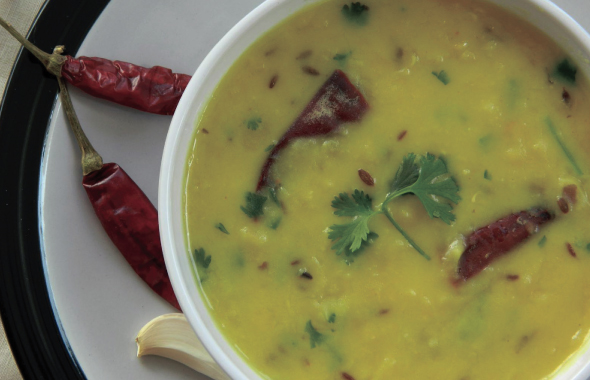Mama’s Punjabi Recipes – Dhuli Moong Di Dal (Skinless Split Moong Lentils)
Dhuli moong dal is one dal that many people really like because it can be easily made but just as many people dislike it because it is made too carelessly and dissolves into a soup. It is one of the favored dals of religious places and when there are large groups of people to feed, like in schools.
It is not an inexpensive dal but since it cooks so easily it is the most commonly cooked dal all over India. Since it is also very easily digestible, this dal is often served to ill people or those with an upset stomach. Sometimes, the water it is cooked in is drunk like a thin soup by sick people to give them nourishment.
Where it has to have a thicker quality to be flavorful, this dal cooks in almost ten minutes in a pot and when allowed to simmer for a little while comes out as whole grains. Unfortunately, people often overcook it and the end result is sadly a soup, like a kaddi, which can only be eaten with rice or a spoon. In some parts of India, this is the way it is eaten, but not so in the Punjab
Dhuli moong dal is also deep fried to become crispy and then mixed with salt and pepper and even other fried dals and savories to be eaten as a snack. It then has a soft crunchiness to it which people love and it is offered at many gatherings, just like chips and peanuts.
Try this dish with ½ cup of dhuli moong dal and ½ cup of massoor dal for a unique taste.
One of the simplest and tastiest ways to eat cooked dhuli moong dal is the rustic way: with some roti, a simpler vegetable dish and some raw, unsalted, unspiced onions. That is the real food of the rural Punjabis and Northern Indians.
Ingredients:
1 cup dhuli moong dal (skinless split moong lentils)
2 cups pani (water)
2 tbspn olive oil
1 medium adrak (ginger) – peeled and chopped, or use powdered ginger
1 tspn jeera (cumin)
1 tspn garam masala
5 stalktops fresh dhania (coriander) – pinch off the leaves and cut into pieces
Spices: lal mirch (red pepper); namak (salt); haldi (turmeric) – to your taste
Directions:
1. Place the dhuli moong dal in a bowl and wash it thoroughly in cold water, then rinse it out.
2. Bring the 2 cups of water to a boil over high heat. Pour in the dhuli moong dal into the pot, cover, and add the haldi, ginger and salt and let it come to a second boil for 10 minutes then reduce the heat to medium.
3. If the water boils off before the dal becomes tender, then add some more warm water and let it continue to boil for another 2 minutes till the dal is tender but not soft. Never add cold water to the dal.
4. Keep a frequent eye on the dal to make sure it does not become soupy. Turn the heat off and let the dal sit.
5. Heat the oil in a small karai or wok and add the jeera and lal mirch and brown it a little. When roasted and the smell of the cumin starts to come through, take off the heat and drop the masala into the pot of cooked dal and stir to mix well.
6. Sprinkle the top of the dal with garam masala and the cut coriander leaves above.
Shakuntla Malhotra is a skilled cook of Punjabi dishes made in the old-fashioned style that she learnt as a young woman in her ancestral home in Lyallpur, India before it became part of Pakistan after the Partition in 1947. People have often admired her cooking for its simplicity and taste that comes with each mouthful. Even in her mid-eighties, she continues to cook daily and agreed to share some of her delectable Punjabi recipes.
MAMA’S TIP OF THE WEEK
CUT GREEN LEAVY VEGETABLES WITH SHARP SCISSORS
Some favorite vegetables like spinach, collard greens and methi or even mint or coriander stalks require a lot of work to clean and then cut before preparing. In India, one simply asks the sabziwala (vegetable seller) to cut them for you and then he will run it through a very sharp spiraling blade and bring you the cut vegetables. This is not the same as putting them leaves in a blender or food processor which will give you watery choppings.
There is an easy way to get the same results at home. Just use sharp scissors and cut the leaves as you would a piece of cloth. This is a really time saving method to chop stalks and leaves without squeezing the water out of them.


